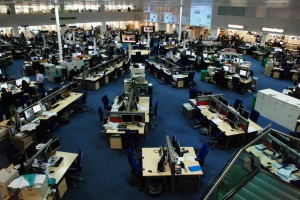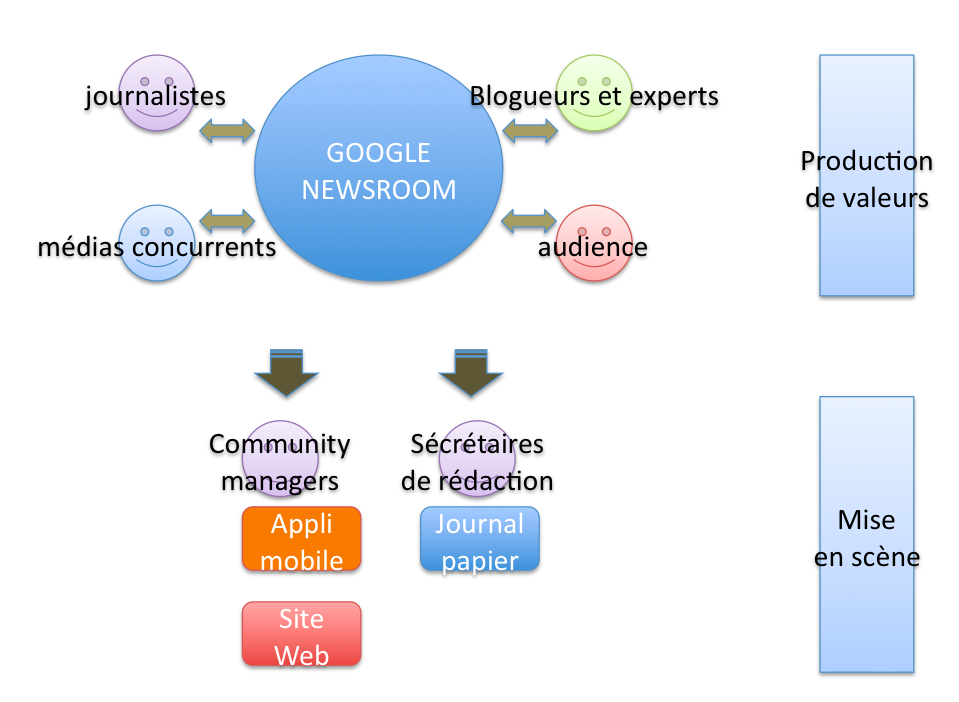Towards the Google Newsroom,||a revolution for media
Owni entame aujourd'hui un cycle de traduction des articles que vous avez préférés sur la soucoupe. Ce n'est que la première de nombreuses surprises à venir. Nous commençons par un article de Benoit Raphaël, rédacteur en chef du Post (Update 3 mars: celui-ci vient d'annoncer son départ) . Bienvenue à bord aux nouveaux venus ! Today Owni starts a new cycle : we will translate some of the articles that you liked the most. It is only the first surprise of a lot more to come. We start here with the translation of an article written by Benoît Raphaël, editor in chief at Le Post. Welcome aboard to foreign friends !
Owni entame aujourd’hui un cycle de traduction des articles que vous avez préférés sur la soucoupe. Ce n’est que la première de nombreuses surprises à venir.
Nous commençons par un article de Benoit Raphaël, rédacteur en chef du Post (UPDATE).

Bienvenue à bord aux nouveaux venus !
Today Owni starts a new cycle : we will translate some of the articles that you liked the most. It is only the first surprise of a lot more to come. We start here with the translation of an article written by Benoît Raphaël, editor in chief at Le Post.
Welcome aboard to foreign friends !
—
Turbulent times can become very productive to create new ideas. In my spare time, I had the chance to think about the concept of a blended newsroom combining harmoniously web and print dimensions. Since I found this issue fascinating , I decided to share it with you and start a conversation.
It has long been talking about models of integrated newsrooms (the best known is the one Ifra suggested). Another one is Daily Telegraph’s integrated newsroom. Quite scary at first glance, hum?

But very often theoretical models clash with day-by-day reality of newsrooms that include today a large majority of print-oriented journalists with small web experience. If you ask them to write both for print and web, you’ll get them torn between two media. This produces two blocks:
1) The web is not a pipe in which you can put any type of content. Print articles are very often unsuitable for web and mobile use. Just think that at LeMonde.fr, print articles represent 30% of production, but less than 15% of traffic. You can not just write and redirect to a pipe. To produce a content you have to take an evolving environment into account
People make the same mistake today with mobile phones, when they pretend to replicate there the same content that has been conceived for desktop devices.
2) Journalists become schizophrenic. They become “bi-media” and feel they are bi-working, which for them means “twice”… As a consequence, they keep producing with a print-oriented vision.
Thus, we have to forget that old idea of merging newsrooms. And make a choice: go where the information breathes, where readers/users are connected and involved. Create one newsroom “where everything happens,” that is to say on the web. This is the heart of information system. The rest is just appearance.
Why the web ? Because the Google era has changed everything. And generated the emergence (and necessity) of the so-called networked journalism. A journalism that is not just content production but becomes an on-going process that is based on the strength of the network (information fragmentation, new rhythms, social media, user generated content…) to produce and distribute information.
You will then get neither one “bi-media” newsroom or two, but three that I would divide into 2 subgroups:
One Creation-oriented journalism (the Google Newsroom)
One Curation-oriented Journalism (community management and copy desk)
Note that I do not use the word “journalist” but “journalism”. Journalism taken not as a profession but as a (precious) function – where sharing journalistic skills with amateurs is considered as a strength.
Take the example of a newspaper. Let’s call it “The Hope” :
- 100.000 copies / day
- 1 €
- 36 pages.
- Print newsroom: 85 journalists + 7 copy editors.
- Web newsroom: 7 journalists + 1 community manager.
That means 100 journalists.
A beautiful newsroom. But there is not a single market where they are leader. Not enough people on the web, too few on the paper.
Now imagine a new version. Always with our 100 journalists. But in this case the newsroom will be so focused on the “digital” dimension that it will be number one on the web and mobile information.
At the same time, The Hope will publish a newspaper of highest quality which will enable it to increase sales – and perhaps the price. Incidentally, it will earn more money.

1 – One Creation-oriented journalism: the Google Newsroom
Composed of 80 of your journalists, but also integrating other journalistic productions (via link journalism), blogging and user generated content managed by the media.
Your 80 journalists are gathered into 10 business units, ie in thematic clusters. Just as an independent media (which could be branded in another way) managed (or not) by a cluster manager, around which you can gather 8 journalists, bloggers, a community + 1 marketing + 1 sales officer (they can work on multiple clusters).
Each cluster can also have its copy editor and its associated community manager.
(One can also imagine 3 large clusters of 16 journalists and 3 clusters of 10 journalists etc.).
In each cluster, we will produce creation-oriented journalism. The driving question must be: since everyone covers approximately the same information on the network, what is my added value?
You will thus find:
- Reporters (Journalists + bloggers): they don’t “cover” news, they don’t replicate press agencies wires, they bring original stories.
They go on the real or virtual ground. They publish with a large array of rhythms: live tweeting, articles, videos, data, in-depth investigation… They can also manage a community of bloggers / users with whom they can co-produce the news.
- Curators (journalists + amateurs) : they “cover” the news by sorting, verifying and editing live everything good existing on the web and in the media. They make link journalism, they make the news more accessible.
- Columnists (bloggers, journalists, experts): they start conversations and give stories another perspective.
2 – A Curation-oriented journalism:
- A team of 10 super-copy-editors, in charge of curating the news in 36 pages. They work only on 3 or 4 pages each, but they have a real old-school copy-editing job. They retrieve the content published by the Google Newsroom and make it live in a different way. They are in charge of making the news more readable and more visual. They do with the paper everything that the web can not do.
A fine example of what the paper is capable is the Portuguese newspaper “I”.

With the support of copy-editors, each “digital” business unit may decide to produce printed special issues.
- A team of 10 community journalists and database-journalists, in charge of curating the information on the web and mobile. In fact, they are primarily responsible for user experience with the news. They take care of the quality of users’ engagement.
They also work on curating the information in the form of databases (like the New York Times).

They also organize the content in topics pages assembling in one web page all that you should know about a topic (posts, links, tweets, cold data, etc.). The Huffington Post do it very well with their Big News Pages.
The result of all this is a networked, powerful, completely reorganized newsroom : The Google Newsroom.
With 80 Google Journalists, this would be France’s first online newsroom.
Imagine the same thing with the 200 journalists that work today in big national daily newspapers.
You will tell me: will your 80 journalists be able to go on the web ? In most newsrooms, the “web level” is close to zero.
I think so. What is blocking is rather bi-media, schizophrenia. Now, if the message and the environment is clear, if he/she is properly trained, a good journalist will do good journalism.
The most reluctant will have the chance of having fun with a creative form of copy-editing.
It is a model that can easily be duplicated to television and radio.
What do you think about all this ?
—
» The original article (in french) and a reaction by Mikiane from France24 (in french too)
» Translation by Adriano Farano (and a litte bit by Guillaume Ledit) /-)
» Homepage illustration by mediamolecule sur Flickr

Laisser un commentaire